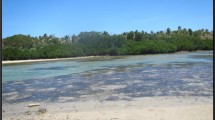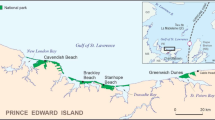Abstract
Undiscovered petroleum resources may be assessed using a computer program that simulates drilling each trap in a play and estimates the size of each potential discovery by multiplying together estimates of area of closure (A cles) and resources per unit area (V A ). There are several ways of determining values forA cles andV A so that the method can be widely applied. As an example, the sales gas potential of part of the Cooper Basin in South Australia is assessed using statistical projections of loglinear models to determine values forA cles andV A . A discontinuity in these particular data appears to result from an improvement in the quality and density of the seismic surveying, demonstrating that an assessment based on widely spaced or poor-quality seismic surveys can underestimate sales gas potential.
Similar content being viewed by others
References
Baker, R.A., Gehman, H.M., James, W.R., and White, D.A., 1986, Geologic field number and size assessments of oil and gas plays,in Rice, D.D., ed., Oil and gas assessment-Methods and applications: AAPG Studies in Geology No. 21, p. 25–31.
Barouch, E., and Kaufman, G.M., 1976, Probabilistic modeling of oil and gas discovery,in Conference on Energy-Mathematics and models, Alta, Utah, July 7–11, 1975: Philadelphia, Society for Industrial and Applied Mathematics, p. 133–150.
Bishop, R.S., Gehman, H.M., Jr, and Young, A., 1983, Concepts for estimating hydrocarbon accumulation and dispersion: AAPG Bulletin, v. 67, p. 337–348.
Bureau of Mineral Resources, Geology and Geophysics, 1988, Australia's petroleum potential,in Petroleum in Australia—The first century: Sydney, Australian Petroleum Exploration Association Limited, p. 48–90.
Davies, O.L., 1961, Statistical methods in research and production: London, Oliver and Boyd, 396 p.
Forman, D.J., 1986, Australia's potential for further petroleum discoveries (from May 1986): Bureau of Mineral Resources, Australia, Record 1986/34, 6 p.
Forman, D.J., Cadman, S.J., Hinde, A.L., and Radlinski, A.P., 1989, Assessment of petroleum plays containing complex traps,in Abstracts: 28th International Geological Congress, Washington, D.C., USA, July 9–19, 1989, v. 1, p. 501.
Forman, D.J., and Hinde, A.L., 1985, Improved statistical method for assessment of undiscovered petroleum resources: AAPG Bulletin, v. 69, p. 106–118.
Forman, D.J., and Hinde, A.L., 1986, Examination of the creaming methods of assessment applied to the Gippsland Basin, offshore Australia,in Rice, D.D., ed., Oil and gas assessment—Methods and applications: AAPG Studies in Geology No. 21, p. 101–110.
Forman, D.J., Hinde, A.L., Cadman, S.J., and Radlinski, A.P., 1993, Towards assessment of plays containing migrated petroleum,in Harff, J., and Merriam, D.F., eds., Computerized basin analysis—The prognosis of energy and mineral resources: New York, Plenum Press, p. 275–299.
Forman, D.J., Hinde, A.L., and Radlinski, A.P., 1990, Importance of the reservoir/cap rock contact in assessment of undiscovered petroleum resources,in Conference on Basin Perspectives, 1990 CSPG Convention, Calgary, May 27–30: Canadian Society of Petroleum Geologists, p. 56.
Forman, D.J., Hinde, A.L., and Radlinski, A.P., 1992, Assessment of undiscovered petroleum resources by the Bureau of Mineral Resources, Australia: Energy Sources, v. 14, p. 183–283.
Hinde, A.L., 1986, VALAL and ASSAD—Two computer programs for estimating and summing undiscovered petroleum resources: Bureau of Mineral Resources, Australia, Record 1986/30, 17 p.
Kantsler, A.J., Prudence, T.J.C., Cook, A.C., and Zwigulis, M., 1983, Hydrocarbon habitat of the Cooper/Eromanga Basin, Australia: The APEA Journal, v. 23, p. 75–92.
Kapel, A.J., 1972, The geology of the Patchawarra area, Cooper Basin: The APEA Journal, v. 12, p. 53–57.
Kaufman, G.M., 1986, Finite population sampling methods for oil and gas resource estimation,in Rice, D.D., ed., Oil and gas assessment—Methods and applications: AAPG Studies in Geology No. 21, p. 43–53.
Kaufman, G.M., Balcer, Y., and Kruyt, D., 1975, A probabilistic model of oil and gas discovery,in Haun, J.D., ed., Methods of estimating the volume of undiscovered oil and gas resources: AAPG Studies in Geology No. 1, p. 113–142.
Kendall, M.G., and Stuart, A., 1967, The advanced theory of statistics (2nd ed.), v. 2: London, Charles Griffin and Company, 690 p.
Masters, C., Robinson, K., Procter, R., and Taylor, G., 1986, Petroleum resource assessment, East Asia workshop: Kuala Lumpur, Committee for Coordination of Joint Prospecting for Mineral Resources in Asian Offshore Areas (CCOP) and International Union of Geological Sciences (IUGS), 79 p.
McDowell, A.N., 1975, What are the problems in estimating the oil potential of a basin?: The Oil and Gas Journal, p. 85–90.
Monnier, F., Powell, T.G., and Snowdon, L.R., 1981, Qualitative and quantitative aspects of gas generation during maturation of sedimentary organic matter. Examples from Canadian frontier basins,in Advances in organic geochemistry: New York, John Wiley and Sons Limited, p. 487–495.
O'Carroll, F.M., and Smith, J.L., 1980, Probabilistic methods for estimating undiscovered petroleum resources: MIT Energy Laboratory Working Paper, MIT-EL 80-008 WP, 59 p.
Root, D.H., Attanasi, E.D., and Masters, C.D., 1986, Some practical approaches to world petroleum assessment,in Rice, D.D., ed., Oil and gas assessment—Methods and applications: AAPG Studies in Geology No. 21, p. 185–193.
Shapiro, S.S., and Wilk, M.B., 1965, An analysis of variance test for normality (complete samples): Biometrica, v. 52, no. 3, 4, p. 591–611.
Sluijk, D., and Nederlof, M.H., 1984, Worldwide geological experience as a systematic basis for prospect appraisal,in Demaison, G., and Murris, R.J., eds., Petroleum geochemistry and basin evaluation: AAPG Memoir 35, p. 15–26.
Smyth, M., 1979, Hydrocarbon generation in the Fly Lake-Brolga area of the Cooper Basin: The APEA Journal, v. 19, p. 108–114.
Williams, B.P.J., and Wild, E.K., 1984, The Tirrawarra Sandstone and Merrimelia Formation of the southern Cooper Basin, South Australia—The sedimentation and evolution of a glaciofluvial system: The APEA Journal, v. 24, p. 377–392.
Author information
Authors and Affiliations
Rights and permissions
About this article
Cite this article
Forman, D.J., Hinde, A.L. & Cadman, S.J. Use of closure area and resources per unit area for assessing undiscovered petroleum resources in part of the Cooper Basin, South Australia. Nat Resour Res 4, 60–73 (1995). https://doi.org/10.1007/BF02257017
Received:
Revised:
Accepted:
Issue Date:
DOI: https://doi.org/10.1007/BF02257017




